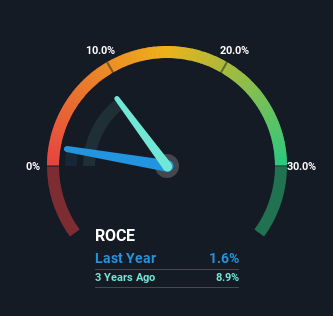- Spain
- /
- Construction
- /
- BME:ACS
Returns On Capital Signal Tricky Times Ahead For ACS Actividades de Construcción y Servicios (BME:ACS)

To find a multi-bagger stock, what are the underlying trends we should look for in a business? Firstly, we'd want to identify a growing return on capital employed (ROCE) and then alongside that, an ever-increasing base of capital employed. If you see this, it typically means it's a company with a great business model and plenty of profitable reinvestment opportunities. However, after investigating ACS Actividades de Construcción y Servicios (BME:ACS), we don't think it's current trends fit the mold of a multi-bagger.
What Is Return On Capital Employed (ROCE)?
For those who don't know, ROCE is a measure of a company's yearly pre-tax profit (its return), relative to the capital employed in the business. Analysts use this formula to calculate it for ACS Actividades de Construcción y Servicios:
Return on Capital Employed = Earnings Before Interest and Tax (EBIT) ÷ (Total Assets - Current Liabilities)
0.016 = €322m ÷ (€25b - €5.0b) (Based on the trailing twelve months to March 2023).
So, ACS Actividades de Construcción y Servicios has an ROCE of 1.6%. Ultimately, that's a low return and it under-performs the Construction industry average of 9.5%.
View our latest analysis for ACS Actividades de Construcción y Servicios

In the above chart we have measured ACS Actividades de Construcción y Servicios' prior ROCE against its prior performance, but the future is arguably more important. If you'd like to see what analysts are forecasting going forward, you should check out our free report for ACS Actividades de Construcción y Servicios.
How Are Returns Trending?
When we looked at the ROCE trend at ACS Actividades de Construcción y Servicios, we didn't gain much confidence. Around five years ago the returns on capital were 14%, but since then they've fallen to 1.6%. Although, given both revenue and the amount of assets employed in the business have increased, it could suggest the company is investing in growth, and the extra capital has led to a short-term reduction in ROCE. And if the increased capital generates additional returns, the business, and thus shareholders, will benefit in the long run.
On a side note, ACS Actividades de Construcción y Servicios has done well to pay down its current liabilities to 20% of total assets. That could partly explain why the ROCE has dropped. What's more, this can reduce some aspects of risk to the business because now the company's suppliers or short-term creditors are funding less of its operations. Some would claim this reduces the business' efficiency at generating ROCE since it is now funding more of the operations with its own money.
The Key Takeaway
Even though returns on capital have fallen in the short term, we find it promising that revenue and capital employed have both increased for ACS Actividades de Construcción y Servicios. These trends are starting to be recognized by investors since the stock has delivered a 12% gain to shareholders who've held over the last five years. Therefore we'd recommend looking further into this stock to confirm if it has the makings of a good investment.
On a separate note, we've found 2 warning signs for ACS Actividades de Construcción y Servicios you'll probably want to know about.
If you want to search for solid companies with great earnings, check out this free list of companies with good balance sheets and impressive returns on equity.
New: Manage All Your Stock Portfolios in One Place
We've created the ultimate portfolio companion for stock investors, and it's free.
• Connect an unlimited number of Portfolios and see your total in one currency
• Be alerted to new Warning Signs or Risks via email or mobile
• Track the Fair Value of your stocks
Have feedback on this article? Concerned about the content? Get in touch with us directly. Alternatively, email editorial-team (at) simplywallst.com.
This article by Simply Wall St is general in nature. We provide commentary based on historical data and analyst forecasts only using an unbiased methodology and our articles are not intended to be financial advice. It does not constitute a recommendation to buy or sell any stock, and does not take account of your objectives, or your financial situation. We aim to bring you long-term focused analysis driven by fundamental data. Note that our analysis may not factor in the latest price-sensitive company announcements or qualitative material. Simply Wall St has no position in any stocks mentioned.
About BME:ACS
ACS Actividades de Construcción y Servicios
ACS, Actividades de Construcción y Servicios, S.A.
Average dividend payer and fair value.


